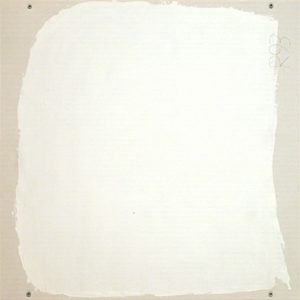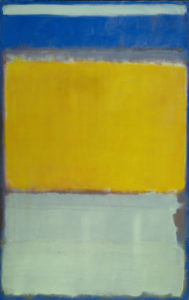Dear Artist,
Robert Ryman was a 22-year-old aspiring jazz musician who moved to New York City in 1953 and took a day job as a vacation-relief security guard at the Museum of Modern Art. There, he encountered the newly acquired Number 10, 1950 by Mark Rothko, part of the museum’s collecting spree of abstract expressionist paintings.
“His work wasn’t like a picture — like the usual pictures I had seen. That was a revelation,” said Robert. Growing up almost never seeing a painting, he may have felt that Number 10 was, instead of an illusion or reference to something else, an unapologetic, physical entity all on its own. Robert began using this condition — the qualities of wonder and delight, including Rothko’s physical approach of assessing everything in the museum and beyond — to look for a painting’s capacity to assert itself independently upon its surroundings and itself, just as it was. At the time, this “nakedness” came across as radical and enlightening.
In 1955, after two years at the museum, Robert bought some art supplies and began experimenting in his East 60th Street apartment. “I thought I would try and see what would happen,” he said. “I wanted to see what the paint would do, how the brushes would work.” He began exploring the idea of superseding any reference to sources outside the painting object — an “abstraction,” a term he disliked, but abstracted from nothing. His goal was to understand painting in terms of its materials and behaviour — treating it as an object. The deep edges, side drips, and the visible staples of Number 10 inspired Robert to begin. “It was so open.”
Robert would experiment with every kind of fastener and, for a time, hung his canvases perpendicular to the wall with metal struts. He eschewed colour in favour of the reflective and noiseless qualities of white, working in it almost exclusively for six decades. When he was 36, his first solo show kicked off with his being lumped in with the Minimalists and Conceptual artists. He said that it was never his intention to make white paintings. “The white is just a means of exposing other elements. White enables other things to become visible.” In 1992, Robert’s own retrospective was mounted at the Museum of Modern Art.
Sincerely,
Sara
PS: “Wow, what is this? I don’t know what’s going on, but I like it.” (Robert Ryman)
Esoterica: Robert Ryman was born in Nashville, the son of an insurance salesman, and a teacher and amateur pianist. He studied to be a teacher and served in the army reserve corps, where he played in a reserve band during the Korean War. Once in New York, Robert continued working at the Museum of Modern Art for seven years, while building his own art practice. Unlike the many artists whose work follows a trajectory arc of discovery and progress, Robert happened upon his calling and process at the moment he discovered his first painting. On February 8, 2019, Robert Ryman died at home in Greenwich Village. He was 88.
“I don’t like this word abstract… but I use it because people… have an idea what I’m talking about.” (Robert Ryman)
Have you considered joining our Premium Artist Listings? Share your work with thousands of readers. 100% of your listing fee contributes to the production of The Painter’s Keys. Thanks for your friendship.
“There is never any question of what to paint, only how to paint.” (Robert Ryman)
Featured Workshop
Do you feel stuck in a rut? Need time to reflect on transitions? Long for an extended art-play date? Join Ellie Harold for a unique expressive art-making retreat for 12 women in colonial San Miguel de Allende, Mexico. Re-establish flow in your life through painting, movement, soulful discussion, and a wealth of cultural, visual and culinary delights. (Everyone has their own room!)
Art practice will encourage intuitive use of color and expressive mark-making with emphasis on process rather than technique. Materials provided or you can bring your own.
An inspired facilitator and prolific oil painter, Ellie invites all experience levels (including none) to participate in Painting for Pleasure.
Visit Ellie’s website to learn more.
Featured Artist
Candace studied at the Ecole des Beaux Arts in Angers, France but it is her travels in the deserts of Africa and Oman, Antarctica and the Arctic, and sacred sights of Machu Picchu and Petra that serve as her true place of learning. A desire to combine these experiences with a deeper understanding of her own spirituality has provided the underlying focus and inspiration for her paintings.









16 Comments
I love Rothko even though I don’t generally paint abstract pieces myself. I can see how Mr. Ryman was so inspired to do his own work exploring one color. I don’t think I could do that for decades. I admire the artist who can focus on just one image, color, idea or what have you like Frida Kahlo who, out of necessity, only had her image to paint so much of her life. If I only had myself to paint I think I would go utterly insane. I can’t look at myself too long without getting depressed. The Abstract Expressionist were really a very focused group of artist all exploring differing expressions of painting like Alice Martin whose work is so subtle it can’t really be viewed except in person. Focus, I know, is part of the mental makeup of every artist but to be so extremely focused seems either super-human or insane to me.
Do you mean Agnes Martin?
“working in it [white paint] almost exclusively for six decades”…. Wow… Sorry, but I could be the richest person in the world and I wouldn’t bid $10 at an auction for either of these artist’s work (and many others). But, that’s just me and it takes all sorts, right…?
I agree. I don’t have that New York frame mind. I do admire his persistence and that he made a living at it.
Robert Ryman had support from the DIA Foundation, which ain’t too shabby.
Thank you for memorializing this man, telling his story for me to learn.
If I understand him correctly, I don’t believe Mr. Ryman’s view, “There is never any question of what to paint, only how to paint,” serves art’s highest calling. Life is all about story. Story informs us about life. Just attend a memorial service for evidence of that.
It could be that he meant he didn’t have to worry about subject matter. In his case, that was certainly true – he only had one subject for years and years.
Mr, Ryman died recently. There was a lovely obit in the NY Times.
The King is in the all together.
Indeed.
Thank you for sharing the story of a self-made, successful artist. I am sorry to learn of his passing. His story is an inspiration to aspiring artists.
Robert Ryman’s dedication to white as an abstraction of nothing has spilled over to controversial artistic expressions in the high world of NYC art. He had an opportunity and ran with it. Kudos to him for making it work during his six decades of creating art. I really enjoyed his later works with patches of black in his abstractions, albeit, in my mind more non-objective artworks. There lies the controversy. An abstraction of nothing? Hmmm…..it brings to mind claiming art for Art’s sake as Marcel Duchamp’s, signed Urinal. What I also like about Robert Ryman’s work is the exploration in texture, line and subtleties of expressing white. May he rest in white peace. We, as artists, have once again learned a glimpse of an artist’s self expression.
Much thanks to you for sharing the tale of an independent, fruitful craftsman. I am sorry to learn of his passing. His story is a motivation yearning for craftsmen.
Please check best interior design companies in Dubai.
Some years ago, I saw a Ryman retrospective at the Walker in Minneapolis. It was a stunning experience. This huge space filled with explorations of working with paint. It was only enhanced by the fact that there were almost no other people in the museum at the time. I will never forget the power and beauty of that exhibition.